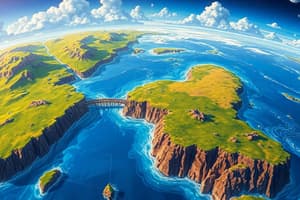Podcast
Questions and Answers
What is the outermost solid shell of a rocky planet or natural satellite?
What is the outermost solid shell of a rocky planet or natural satellite?
- Lithosphere
- Core
- Crust (correct)
- Mantle
What layer lies between the crust and the outer core?
What layer lies between the crust and the outer core?
Mantle
What are the two components of Earth's core?
What are the two components of Earth's core?
Outer core and inner core
What includes both the crust and the uppermost mantle?
What includes both the crust and the uppermost mantle?
What is the layer of the Earth's upper mantle called that extends from 75 km to about 200 km deep?
What is the layer of the Earth's upper mantle called that extends from 75 km to about 200 km deep?
Which layer of the Earth's atmosphere is directly above the stratopause?
Which layer of the Earth's atmosphere is directly above the stratopause?
What is the approximate thickness of the outer core?
What is the approximate thickness of the outer core?
What is the Earth's innermost part called?
What is the Earth's innermost part called?
What term describes the rigid outermost shell of a planet divided into plates?
What term describes the rigid outermost shell of a planet divided into plates?
What is the term for the movement of the Earth's continents relative to each other?
What is the term for the movement of the Earth's continents relative to each other?
What term describes the process of new ocean floor being created?
What term describes the process of new ocean floor being created?
What term refers to the process at convergent plate boundaries where one tectonic plate moves under another?
What term refers to the process at convergent plate boundaries where one tectonic plate moves under another?
What type of tectonic boundary occurs where two plates move away from each other?
What type of tectonic boundary occurs where two plates move away from each other?
What is the process called where two tectonic plates slide alongside each other?
What is the process called where two tectonic plates slide alongside each other?
What do we call the external force acting parallel to a surface that can produce shear?
What do we call the external force acting parallel to a surface that can produce shear?
What is the action of being squished down or made smaller called?
What is the action of being squished down or made smaller called?
Flashcards are hidden until you start studying
Study Notes
Earth's Crust and Structure
- The crust is the Earth's outermost solid shell, chemically distinct from the mantle below.
- The mantle lies beneath the crust, composed of silicate rocks with an average thickness of 2,886 km (1,793 mi).
- Earth's core consists of an iron and nickel center, featuring a liquid outer core and a solid inner core, with the outer core starting at a depth of 2,898 km (1,800 mi) and the inner core at 4,983 km (3,090 mi).
Geologic Layers
- The lithosphere encompasses the crust and uppermost mantle, forming the Earth's rigid outer layer, subdivided into tectonic plates.
- The asthenosphere is part of the upper mantle, extending from about 75 km (46.5 mi) to 200 km (124 mi) deep.
- The mesosphere is the layer of the Earth's atmosphere above the stratopause, where temperature decreases with altitude.
Tectonic Plates
- Tectonic plates are sections of the lithosphere, with seven or eight major plates and numerous minor plates on Earth.
- Continental drift refers to the movement of continents relative to each other, creating the appearance of "drifting" across ocean beds.
- Sea-floor spreading is the process of new ocean floor formation as molten material rises between tectonic plates.
Plate Boundaries
- Convergent boundaries occur when tectonic plates collide, often forming subduction zones where denser oceanic crust sinks below less dense continental or oceanic crust.
- Subduction zones are regions where one tectonic plate moves under another, sinking into the mantle at convergent boundaries.
- Divergent boundaries happen when two tectonic plates move apart, allowing magma to rise and create new crust. Examples include the mid-ocean ridge and the middle of the Red Sea.
- Transform boundaries involve tectonic plates sliding past each other, which can cause earthquakes due to friction.
Geological Processes
- Stress is the external force exerted parallel to a slope or plane on an object or surface, leading to potential shear forces.
- Compression describes the action of being pressed together or made smaller, causing changes in geological formations.
Studying That Suits You
Use AI to generate personalized quizzes and flashcards to suit your learning preferences.



